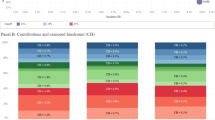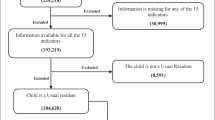Abstract
Measurement of child poverty continues to dominate public and academic discourse. However, a key issue in the literature is that focus is often on the poor or poorest children. There are hardly any studies that compare the distributions and experiences of poor children with vulnerable “non-poor” children, who might have narrowly missed predetermined poverty threshold(s), and are usually at a risk of “falling” into poverty at any slightest negative economic shock(s), especially at the household level. This paper thus develops child-specific vulnerability measures using data from the South African nationally representative surveys and adapted Alkire-Foster methodology. The measures were used to explore change in children’s vulnerability to multidimensional poverty over time. The results indicate that there has been some reduction in the overall children’s vulnerability to poverty. However, the proportion of vulnerable “non-poor” children remains relatively higher than the proportion of children living in chronic poverty. Further findings suggest that household economic (in) activity and education dimensions, relating to household employment opportunities and access to early childhood education and basic schooling, pose a great threat to reducing children’s vulnerability to poverty in South Africa. It is thus recommended that there should be a social policy rethink that strongly admits “vulnerability” ideology into the conventional “pro-poor” social policy discourse.



Similar content being viewed by others
Notes
The censored deprivation score of each child is calculated by taking a weighted sum of the number of deprivations, so that the deprivation score for each child lies between 0 and 1
The censored vulnerability headcount ratio can also be decomposed by socio-demographic factors. Typically, censored headcount ratio is a key measure in poverty index.
References
Alexander, P. (2013). Marikana, turning point in South African history. Review of African Political Economy, 40(138), 605–619.
Alkire, S., Jindra, C., Robles, G., Vaz, A. (2016). Multidimensional poverty index Brief methodological note and results. Oxford: Oxford Poverty and Human Development Initiative (OPHI) Briefing.
Alkire, S., Foster, J., Seth, S., Santos, M. E., Roche, J. M., Ballon, P. (2015). Multidimensional poverty measurement and analysis. Oxford: Oxford University Press.
Alkire, S., & Foster, J. (2011). Counting and multidimensional poverty measurement. Journal of Public Economics, 95(7), 476–487.
Alkire, S., & Santos, M. E. (2014). Measuring acute poverty in the developing world: Robustness and scope of the multidimensional poverty index. World Development, 59, 251–274.
Alliance for Children’s Entitlement to Social Security. (2002). Childhood poverty in South africa, Technical report Alliance for Children’s Entitlement to Social Security. Cape Town, South Africa.
Badat, S., & et al. (2008). Redressing the colonial/apartheid legacy: Social equity, redress and higher education admissions in democratic South Africa. In Conference on Affirmative Action in Higher Education in India, the United States and South Africa (pp. 19–21). New Delhi.
Barnes, H., Wright, G., Noble, M., Dawes, A. (2007). The South African index of multiple deprivation for children: Census 2001 The Human Sciences Research Council. South Africa: Cape Town.
Barnes, H., Noble, M., Wright, G., Dawes, A. (2009). A geographical profile of child deprivation in South Africa. Child Indicators Research, 2(2), 181–199.
Barnes, H., Hall, K., Wright, G. (2011). Review of research evidence on child poverty in South Africa Report for the Monitoring and Learning Facility of the Programme to Support Pro-Poor Policy Development. South Africa: Office of the Presidency.
Barnes, H., Hall, K., Wright, G. (2017). Review of research evidence on child poverty in South Africa Report for the Monitoring and Learning Facility of the Programme to Support Pro-Poor Policy Development. South Africa: Office of the Presidency.
Bond, P., & Mottiar, S. (2013). Movements, protests and a massacre in South Africa. Journal of Contemporary African Studies, 31(2), 283–302.
Bradshaw, J., & John, H. (2010). Child poverty and social exclusion in South Africa. Human Sciences Research Council Press.
Chzhen, Y., & Ferrone, L. (2017). Multidimensional child deprivation and poverty measurement: Case study of Bosnia and Herzegovina. Social Indicators Research, 131 (3), 999–1014.
Chzhen, Y., Gordon, D., Handa, S. (2018). Measuring multidimensional child poverty in the era of the Sustainable Development Goals. Child Indicators Research, 11(3), 707–709.
Coovadia, H., Jewkes, R., Barron, P., Sanders, D., McIntyre, D. (2009). The health and health system of South Africa: Historical roots of current public health challenges. The Lancet, 374(9692), 817–834.
Delius, P., & Glaser, C. (2002). Sexual socialisation in South Africa: A historical perspective. African Studies, 61(1), 27–54.
Frame, E., De Lannoy, A., Leibbrandt, M. (2016a). Measuring multidimensional poverty among youth in South Africa at the sub-national level. Southern Africa Labour and Development Research Unit, University of Cape Town.
Frame, E., De Lannoy, A., Koka, P., Leibbrandt, M. (2016b). Multidimensional Youth Poverty: Estimating the Youth MPI in South Africa at ward level. Southern Africa Labour and Development Research Unit, University of Cape Town.
Fransman, T. (2017). Investigating multidimensional poverty in South Africa in 2001-2016: The multidimensional poverty index (MPI) approach. University of the Western Cape.
Fransman, T., & Yu, D. (2018). Multidimensional poverty in South Africa in 2001–16. Development Southern Africa, 1–31.
Gordon, D. (2003). Child poverty in the developing world. Bristol: The Policy Press.
Gordon, D., & Nandy, S. (2012). Measuring child poverty and deprivation. In Minujin, A., & Nandy, S. (Eds.) Global child poverty and well-being: Measurement, concepts, policy and action, chapter 4 (pp. 57–101). UK: The Policy Press, University of Bristol.
Hall, K. (2012). Income and social grants– children living in poverty The Children’s Institute. Cape Town: University of Cape Town.
Hall, K., & Budlender, D. (2013). 20-Year review: Base paper on the state of children. Unpublished, Paper commissioned by the National Planning Commission for the Presidency’s.
Hall, K., & Sambu, W. (2016). Income poverty, unemployment and social grants.
Hall, K., & Wright, G. (2011). In brief: A profile of children living in South Africa using the National Income Dynamics Study.
Jansen, A., Moses, M., Mujuta, S., Yu, D. (2015). Measurements and determinants of multifaceted poverty in South Africa. Development Southern Africa, 32(2), 151–169.
Kimemia, D. K., & Van Niekerk, A. (2017). Energy poverty, shack fires and childhood burns. South African Medical Journal, 107(4), 289–291.
Kruger, K. J. (2018). Investigating transitory and chronic poverty in South Africa, 2008–2015, University of the Western Cape.
Leibbrandt, M., Woolard, I., Finn, A., Argent, J. (2010). Trends in south african income distribution and poverty since the fall of apartheid organisation for economic cooperation and development (OECD) Social, Employment, and Migration Working Papers.
Martin, P. (2016). Analysis of the children’s sector in South Africa, Pretoria: Save the Children South Africa. Available at https://www.savethechildren.org.za/sites/savethechildren.org.za/files/resources/Analysis%20of%20the%20Children’s%20Sector%20in%20South%20Africa.pdf.Accessed.
Moses, S. (2008). Children and participation in South Africa: An overview. The International Journal of Children’s Rights, 16(3), 327–342.
Münchau, W. (2010). The meltdown years: The unfolding of the global economic crisis. McGraw-Hill.
Ogunbanjo, G. A., & Knapp Van Bogaert, D. (2011). The rights and wrongs of children’s rights. South African Family Practice, 52(6), S13–S18.
Omotoso, K. O., & Koch, S. F. (2018). Exploring child poverty and inequality in post-apartheid South Africa: A multidimensional perspective. Journal of Poverty and Social Justice, 26(3), 417–437.
Read, C. (2008). Global financial meltdown: How we can avoid the next economic crisis. Springer.
Republic of South Africa. (2012). National plan of action for children in South Africa. Pretoria: Department of Women, Children and People with Disabilities.
Richter, L., & Morrell, R. (2006). Baba: men and fatherhood in South Africa. HSRC Press.
Richter, L. M., & Dawes, A. R. L. (2008). Child abuse in South Africa: Rights and wrongs. Child Abuse Review: Journal of the British Association for the Study and Prevention of Child Abuse and Neglect, 17(2), 79–93.
Santos, M. E., & Alkire, S. (2011). Training material for producing national human development reports. Oxford: Oxford Poverty and Human Development Initiative.
Statistics South Africa. (2002). General Household Survey 2002 [Statistical Release P0318 2003], Pretoria: Statistics South Africa [producer], 2003. Pretoria: South African Data Archive, National Research Foundation [distributor].
Statistics South Africa. (2014a). Poverty trends in south africa: An examination of absolute poverty between 2006 & 2011. Statistics South Africa: Pretoria.
Statistics South Africa. (2014b). The South African MPI: Creating a multidimensional poverty index using census data Technical report. Pretoria: Statistics South Africa.
Statistics South Africa. (2017a). General Household Survey 2002 [Statistical Release P0318 2018], Pretoria: Statistics South Africa [producer], 2018. Pretoria: South African Data Archive, National Research Foundation [distributor].
Statistics South Africa. (2017b). Poverty on the rise in South Africa. Statistics South Africa: Pretoria. Available at http://www.statssa.gov.za/?p=10334.
Statistics South Africa. (2017c). Poverty trends in south africa: An examination of absolute poverty between 2006 & 2015. Statistics South Africa: Pretoria. Available at http://www.statssa.gov.za/?p=10341.
Streak, J. C. (2011). Child poverty in South Africa and the performance of the child support grant programme. Western Cape: Stellenbosch University.
Streak, J. C., Yu, D., Van der Berg, S. (2009). Measuring child poverty in South Africa: Sensitivity to the choice of equivalence scale and an updated profile. Social Indicators Research, 94(2), 183–201.
UNICEF. (1989). Convention on the Rights of the Child. UNICEF.
UNICEF. (2008). Facts on children. New York: Author.
United Nations. (2015). United Nations Sustainable Development Goals. UNITED NATIONS.
Von Fintel, M., Zoch, A., Van der Berg, S. (2015). The dynamics of child poverty in South Africa between 2008 and 2012. Child Indicators Research, 1–25.
Wright, G., Noble, M., Barnes, H., Noble, S. (2009). The South African index of multiple deprivation for children 2007 at municipality level. Pretoria: Department of Social Development.
Author information
Authors and Affiliations
Corresponding author
Additional information
Publisher’s Note
Springer Nature remains neutral with regard to jurisdictional claims in published maps and institutional affiliations.
Rights and permissions
About this article
Cite this article
Omotoso, K.O., Adesina, J.O. & Gbadegesin, T.F. Children on the Edge: Estimating Children’s Vulnerability to Multidimensional Poverty in Post-Apartheid South Africa. Child Ind Res 13, 1155–1174 (2020). https://doi.org/10.1007/s12187-019-09677-9
Accepted:
Published:
Issue Date:
DOI: https://doi.org/10.1007/s12187-019-09677-9




